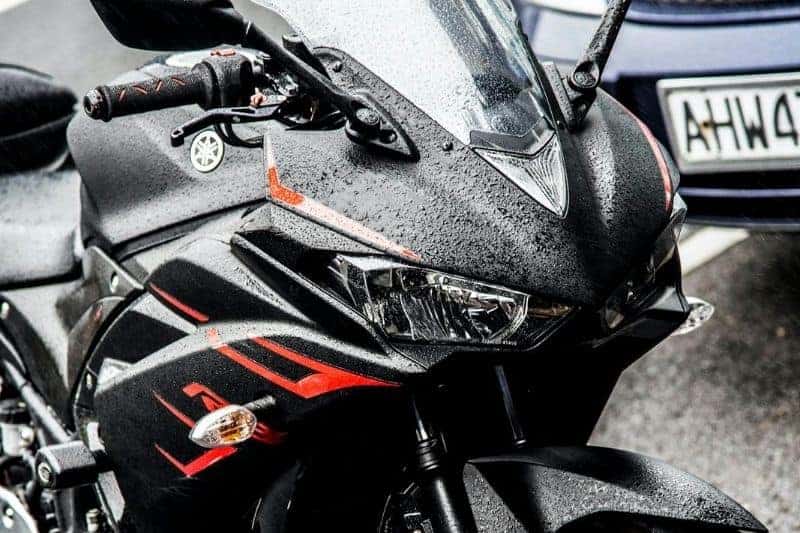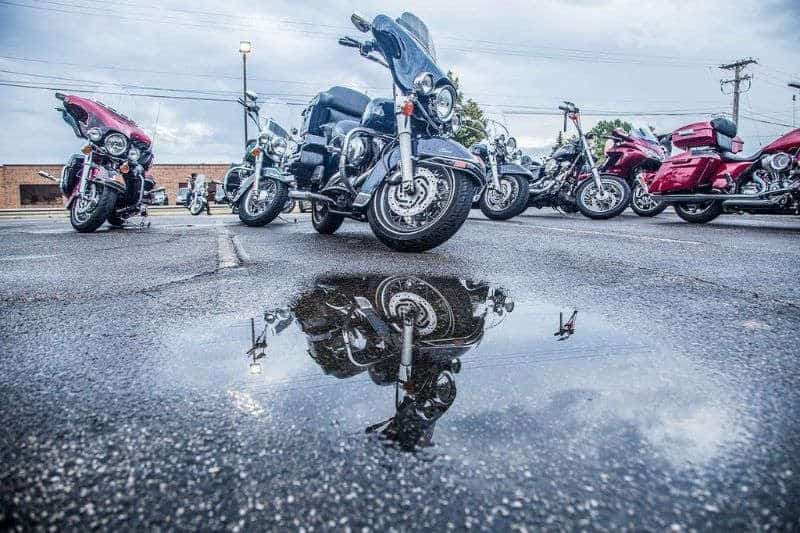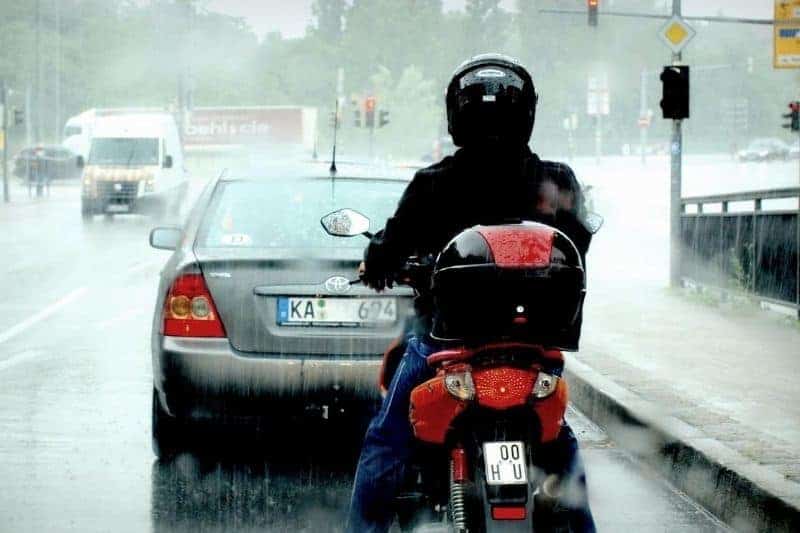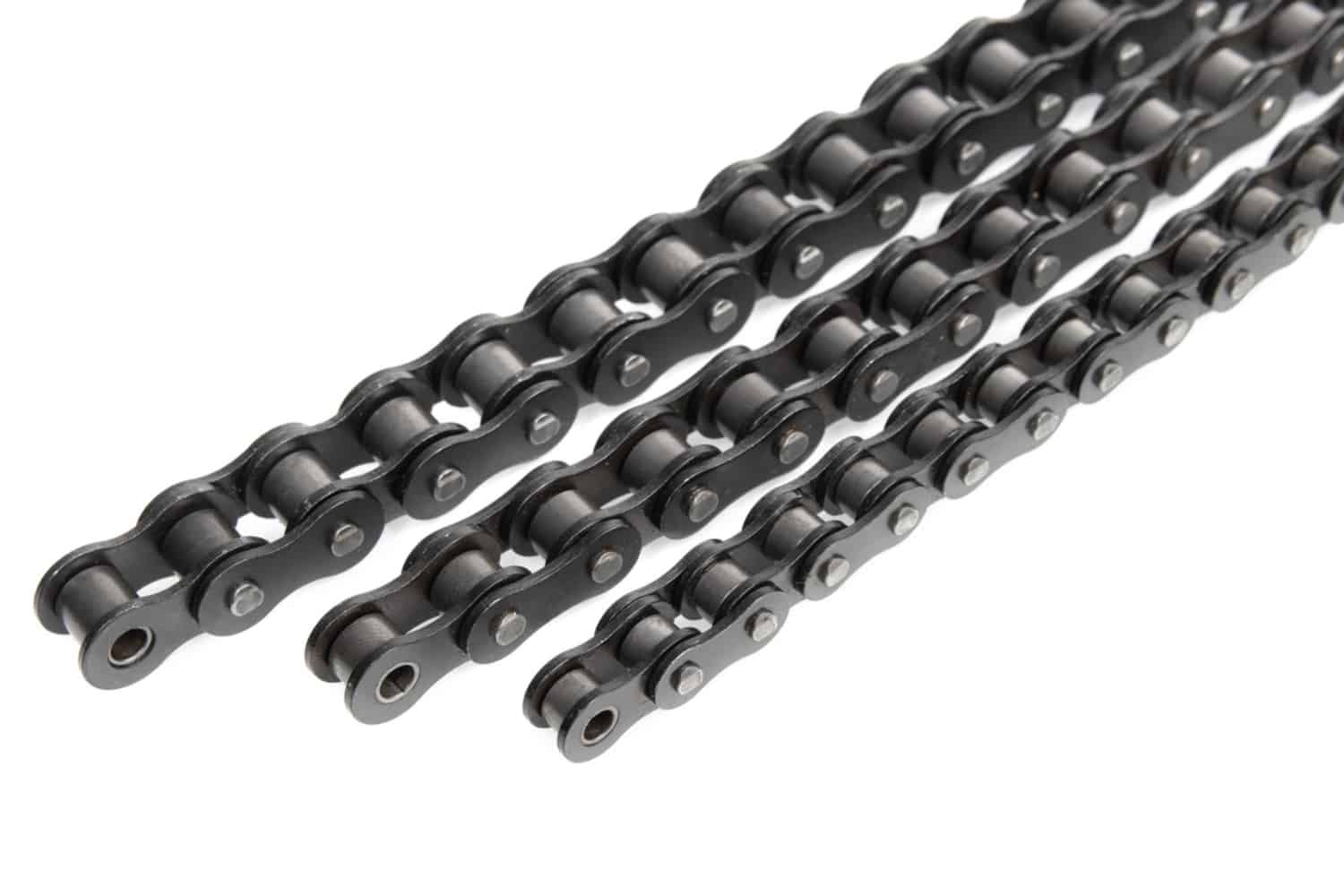Motorcycle riders, in most cases, will avoid riding and even leaving their motorcycles in the rain. However, this does not mean that the occasional shower may not catch you off guard.
This is when a lot of riders will get worried about whether rain exposure can damage their motorcycles.
Will rain damage a motorcycle? Rain will not damage your motorcycle. Motorcycles are designed to be used in the rain. Their electrical components and other sensitive equipment are sealed off and protected from the rain. However, prolonged exposure to rain can cause some parts to rust and corrode, which can be bad for the motorcycle.
Table of Contents
If you ride for long enough, it is inevitable—sooner or later, your motorcycle will be exposed to the rain.
I’ve had numerous occasions when I have been riding during the rain and even left my motorcycle outside only to find it all wet. Below I get into more detail about everything you need to know.

Will leaving a motorcycle in the rain damage it?
Rain can possibly be one of the biggest enemies of motorcycles. Although short-term exposure to rain will not hurt your motorcycle, as most motorcycles have been designed to withstand the occasional shower, long-term exposure, however, can be incredibly detrimental and ruin any motorcycle.
Leaving your motorcycle outside during a rainstorm or riding it while it is raining will not cause some notable damage. The problems come if the motorcycle is continuously left outside for days on end to be rained upon and dry on its own.
If you are riding your motorcycle often, you will not allow water to accumulate on your motorcycle and do its corrosive and rust-inducing work. By riding frequently, you will allow the motorcycle to dry well and keep all the necessary parts well-lubricated and in good working conditions.
In other words, long-term rain (water) exposure combined with leaving your motorcycle sitting for too long are going to be bad for your motorcycle.
Long-term exposure to rain (or water) will lead to corrosion and rust. Both of which are incredibly bad for the motorcycle.
The results of prolonged rain exposure can cause the chain and sprockets to rust and deteriorate faster, the bearings and bolts to wear out and break down, and the paint finish to lose its shine and fade. The top of the forks and the brake discs are also some of the areas where rust tends to accumulate.
The brake, clutch, and kickstand pivots can also be affected by the water. Water can get inside the swingarm as well, which can cause it to rust and corrode, too.
The instruments and the windshield may start to frost and lose their shine with time.
The exposed plastic and rubber parts will also wear out and rot faster than normal. The control switches are also another weak point motorcycles have.
If water from the rain finds its way inside the car or the engine, things can get really bad. This can lead to the engine seizing up, too.
The consequences can be even worse in areas with high humidity, temperature swings, or a salty environment.
Of course, how bad the rust and corrosion will be can vary from motorcycle to motorcycle. Not all motorcycles are created the same. But a newer motorcycle, that is 5 to 10 years, old may do better compared to older models.
What to do if you have to leave your motorcycle in the rain?

If you have no other choice but to leave your motorcycle outside in the rain, then you have two options, really.
One is to get yourself a motorcycle cover. A good motorcycle cover will keep your motorcycle protected from the rain. This will prevent a lot of the negative consequences of rain exposure.
Choosing the right cover is vital as getting the wrong one can cause more problems than solutions.
The cover should be appropriate for your motorcycle. You want it to be a good snug fit. It should also be capable of being secured to the motorcycle in some way.
Otherwise, you are risking it becoming a sail, it will catch the wind. As a result, the wind can easily blow over your motorcycle. Not only that a tipped-over motorcycle will not be protected from the rain, but you are also risking damaging even more parts of the motorcycle.
Cheaper, low-quality covers will not provide suitable protection against rain and can do more harm than good in the long run. A good high-quality cover will allow the motorcycle to vent, provide some UV protection, and have a good waterproofness.
The choice you have is to leave your motorcycle sitting in the rain without any protection. Leaving your motorcycle naked is the last thing you want to do, but sometimes you may not have a choice.
If the motorcycle is already wet, then it is not a good idea to cover it with the cover because this will only trap in the moisture.
Another case when you may not want to use the cover is if the winds are really strong, and you cannot secure the cover in such a way as to prevent it from catching the wind and turning into a sail.
After it stops raining, for the same reason, it is a good practice to remove the cover in order to not trap the water and humidity trap underneath.
Will raiding in the rain damage a motorcycle?

Riding your motorcycle in the rain is not bad for the motorcycle. Motorcycles are made to be used in a variety of different weather conditions, and rain is one of them.
Some people may think that riding in the rain will ruin or damage your motorcycle, but this is simply not true.
The odds of rain damaging your motorcycle are very slim. Riding a motorcycle in the rain is no worse than riding a car in the rain. Unless the motorcycle has been tampered with in some way, and some of its electronics or other sensitive components have been exposed—in which case rain can damage your motorcycle.
However, motorcycles are normally designed with rain in mind.
Of course, frequently riding a motorcycle in the rain can, with time, lead to rust and corrosion if the motorcycle is left wet all the time and not adequately looked after.
Riding your motorcycle in the rain is more dangerous to you than the motorcycle as the traction will be negatively affected, and there is a higher chance of crashing.
Riding in the rain is trickier and may require a different approach. Not to mention that riding during a lightning storm can be extremely dangerous, too.
What is the best way to protect a motorcycle from the rain?
The best way to protect your motorcycle from the damage rain can do to it is by keeping it indoors. This is hands down the best solution for any motorcycle.
Keeping your motorcycle in your garage or shed is the best way to prevent the damage that can stem from rain and water. However, keep in mind that garages, sheds, and other buildings can be damp and have high humidity, which could be bad for the motorcycle.
Of course, not everybody will have access to a garage or have a place where they can leave their motorcycle safely away from the elements.
As noted, purchase a high-quality motorcycle cover. It will be irreplaceable if you don’t have a suitable place to keep your motorcycle.
No matter what you do sooner or later, your motorcycle will be exposed to the rain, so it is necessary to know what to do in that case.
This is where proper maintenance comes into play. The rain will not hurt your motorcycle—but neglect will. If you cannot protect your motorcycle from the rain, you will have to be more diligent about keeping it clean and well-maintained.
More information can be found in my article about how often you should clean your motorcycle.
Make sure to frequently clean and lube your motorcycle’s chain. Give it a good scrub. Clean the calipers. Keep in mind that even if you use a protective cover, rain, and moisture can get to the chain and braking discs, and they will still need to be regularly cleaned.
Clean all the parts that you see and the ones you don’t—don’t forget about the stuff under the fairings and under the tail.
Rub a little grease over the bolts and cover some of the exposed metal parts where rust tends to accumulate with WD-40.
If you see any rust forming anywhere on your motorcycle, make sure to clean it away. Use an anti-seize compound on your bolts and chain adjuster nuts.
Make sure the connections and electronics are all waterproofed and wrapped up—especially if they are aftermarket.
Don’t leave the battery outside—take it inside with you.
Dry your motorcycle if possible (and if you are not going to ride it soon) and try to keep water from accumulating.
During the winter months and in areas where the roads are salted, rain can be extremely harsh on your motorcycle and will require more frequent maintenance. (Salt can be extremely corrosive.)
Usually, you should not run into any problems with your motorcycle just because it has been rained upon. From experience, the problems ensue when something has been tampered with.
If there are exposed electronics, wiring, bad crankcase breather filters, exposed metal parts, steel on bearings, or chipped paint are also not going to fare well in the rain.

Meet Simon, the 46-year-old aficionado behind YourMotoBro. With a lifelong passion ignited by motocross dreams and a Canadian Tire bicycle, Simon’s journey has been nothing short of extraordinary. From coaching underwater hockey to mastering muddy terrains, he’s an authority in thrill and adventure. Certified as an Off-Road Vehicle Excursion Guide and trained in Wilderness First Aid, Simon’s love for bikes is as diverse as his collection—from a robust BMW GSA R1200 to the memories of a Harley Davidson Night Train. By day a respected telephony consultant, by night a motorcycle maestro, Simon’s tales are a blend of expertise, resilience, and undying passion. ?️✨
